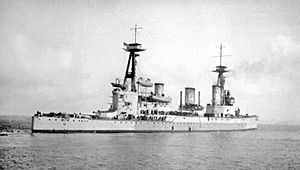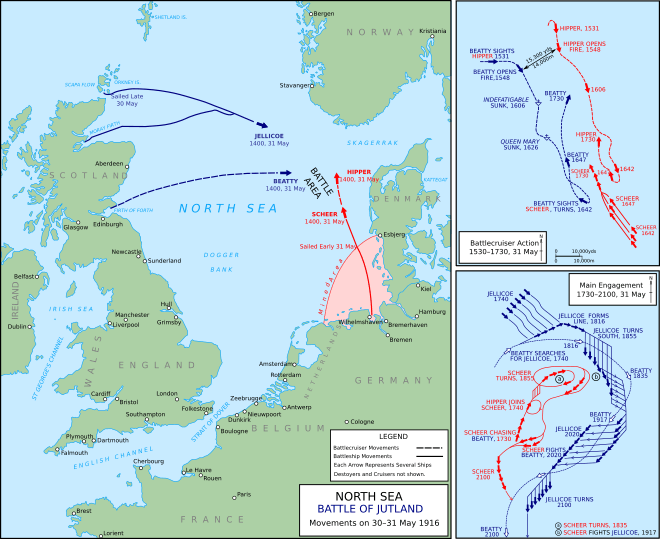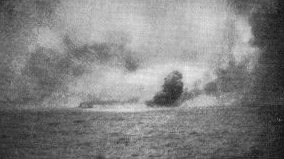HMS Indefatigable (1909) facts for kids

HMS Indefatigable, stern view
|
|
Quick facts for kids History |
|
|---|---|
| Name | Indefatigable |
| Ordered | 1908–1909 Naval Programme |
| Builder | HM Dockyard, Devonport |
| Laid down | 23 February 1909 |
| Launched | 28 October 1909 |
| Commissioned | 24 February 1911 |
| Fate | Sunk during the Battle of Jutland, 31 May 1916 |
| General characteristics | |
| Class and type | Indefatigable-class battlecruiser |
| Displacement | |
| Length | 590 ft (179.8 m) |
| Beam | 80 ft (24.4 m) |
| Draught | 29 ft 9 in (9.07 m) (deep load) |
| Installed power |
|
| Propulsion | 4 × shafts; 2 × steam turbine sets |
| Speed | 25 knots (46 km/h; 29 mph) |
| Range | 6,690 nmi (12,390 km; 7,700 mi) at 10 knots (19 km/h; 12 mph) |
| Complement | 800 |
| Armament |
|
| Armour |
|
HMS Indefatigable was a large warship called a battlecruiser. She was the first ship of her class built for the Royal Navy in the early 1900s. When World War I began, Indefatigable was in the Mediterranean Sea. She tried to catch two German ships, Goeben and Breslau, but they got away.
On November 3, 1914, the ship attacked Turkish forts defending the Dardanelles. After a repair in Malta, she returned to the United Kingdom. Indefatigable was sunk on May 31, 1916, during the Battle of Jutland. This was the biggest naval battle of the war. She was hit many times by shells from the German battlecruiser Von der Tann. Only three of her 1,019 crew members survived.
Contents
Building and Features of HMS Indefatigable
Indefatigable was the only battlecruiser ordered in 1908–1909. The British government wanted to reduce naval spending. However, the navy argued they needed to match Germany's growing fleet. So, they approved one new battlecruiser.
The ship was 590 feet (179.8 m) long and 80 feet (24.4 m) wide. When fully loaded, she weighed 22,130 long tons (22,490 t). She usually had a crew of 737 officers and sailors.
Indefatigable was powered by steam turbines. These engines used steam from 31 coal-burning boilers. The turbines gave the ship 43,000 shaft horsepower (32,000 kW) of power. This allowed her to reach a top speed of 25 knots (46 km/h; 29 mph) (about 46 km/h). During trials, she even reached 26.89 knots (49.8 km/h; 30.9 mph). She could travel 6,330 nautical miles (11,720 km; 7,280 mi) (about 11,723 km) at a slower speed of 10 knots (19 km/h; 12 mph).
Ship's Weapons
The main weapons were eight 12-inch (305 mm) guns. These were in four turrets. Two turrets were at the front and back of the ship ('A' and 'X'). The other two were on the sides, 'P' on the left and 'Q' on the right. These side turrets could fire to both sides.
For smaller targets, she had sixteen 4-inch (102 mm) guns. These were placed around the ship's upper structure. She also had two torpedo tubes, one on each side. These fired 17.72-inch (450 mm) torpedoes. The ship carried twelve torpedoes.
Ship's Protection
Indefatigable had an armoured belt along its waterline. This belt was 4–6-inch (102–152 mm) thick. Her decks had armour between 1.5 and 2.5 inches (38 and 64 mm) thick. The thickest parts protected the steering gear. The gun turrets had 7 inches (178 mm) thick armour on their faces.
A special armoured tower was behind the main control tower. It was protected by 4 inches (102 mm) of armour. However, its view was often blocked. Later, a rangefinder was added to the front turret. This helped aim the main guns.
Changes During the War
In March 1915, Indefatigable received an anti-aircraft gun. This was a 3-inch (76 mm) gun. In November 1915, her 4-inch guns got shields. This protected the gun crews from bad weather and enemy fire. Two of the aft 4-inch guns were removed at this time.
Before May 1916, a fire-control director was installed. This system helped aim all the guns at once. It made shooting much more accurate. The crew in the turrets just followed pointers from the director.
Service History
Early Years
Indefatigable was built at the Devonport Dockyard in Plymouth. Her construction started on February 23, 1909. She was launched on October 28, 1909. The ship was finished and ready for duty on February 24, 1911.
At first, she served in the 1st Cruiser Squadron. This group was later renamed the 1st Battlecruiser Squadron. In December 1913, she moved to the Mediterranean Sea. There, she joined the 2nd Battlecruiser Squadron.
Chasing German Ships
On August 4, 1914, Indefatigable and another battlecruiser, Indomitable, met the German ships Goeben and Breslau. This was before Britain and Germany were officially at war. The British ships followed the Germans as they headed to Messina, Italy.
The German ships managed to escape. They left Messina on August 6 and headed east towards Constantinople. The British commander, Admiral Sir Berkeley Milne, thought they would go west. He waited at Malta for too long. By the time he chased them, the German ships were too far away.
On November 3, 1914, Indefatigable and Indomitable attacked the Dardanelles. This was a test of the Turkish forts. One shell hit a fort's ammunition storage. This caused an explosion and killed many Turkish soldiers. This attack happened before Britain officially declared war on the Ottoman Empire. Indefatigable stayed in the Mediterranean until January 1915. She then returned to England and joined the 2nd Battlecruiser Squadron. For the next year and a half, she patrolled the North Sea.
The Battle of Jutland
On May 31, 1916, Indefatigable was part of Admiral Beatty's Battlecruiser Fleet. They sailed to stop the German fleet in the North Sea. The British knew the Germans were coming because they decoded their radio messages.
Around 3:20 PM, the German battlecruisers spotted the British ships. A few minutes later, the British spotted the Germans. Beatty ordered his ships to turn and prepare for battle. He wanted to cut off the German escape route.
The battle began around 3:48 PM. The German ships fired first. Indefatigable was at the back of the British line. She aimed her guns at Von der Tann. The German fire was very accurate from the start.
Around 4:00 PM, Indefatigable was hit by two or three shells from Von der Tann. The hits were near her rear turret. She began to fall out of line and sink by the stern. At 4:03 PM, her ammunition magazines exploded. This happened after more hits, one on the front of the ship and another on the forward turret. Smoke and flames shot out from the front of the ship. Large pieces of the ship were thrown 200 feet (61.0 m) into the air.
It is believed that the first explosion blew out the bottom of the ship. This also cut the steering controls. Then, the front magazines exploded from more hits. Recent underwater studies show the ship was blown in half very quickly. Von der Tann fired only 52 shells at Indefatigable.
Out of her crew of 1,019, only three people survived. Two survivors found the captain, C. F. Sowerby, in the water. He was badly hurt and died before they could be rescued. Two survivors, Frederick Arthur Gordon Elliott and Charles Farmer, were saved by a German torpedo boat. A third survivor, John Bowyer, was picked up by another German ship.
Indefatigable Today
The wreck of Indefatigable is now a protected site. This is to honor the 1,016 men who died there. Mount Indefatigable in the Canadian Rockies was named after the battlecruiser in 1917.
The wreck was found in 2001. It showed signs of having been heavily salvaged (parts removed). A recent study by archaeologist Innes McCartney found that the first hits caused the rear turret's magazine to explode. This blew off a 40 m-long (130 ft) part of the ship's stern. The powerful shockwave from this explosion likely caused the huge loss of life. The front part of the ship then drifted on before sinking. The two halves of the wreck are now over 500 m (1,600 ft) apart on the seabed.
Images for kids
See also
 In Spanish: HMS Indefatigable (1911) para niños
In Spanish: HMS Indefatigable (1911) para niños






